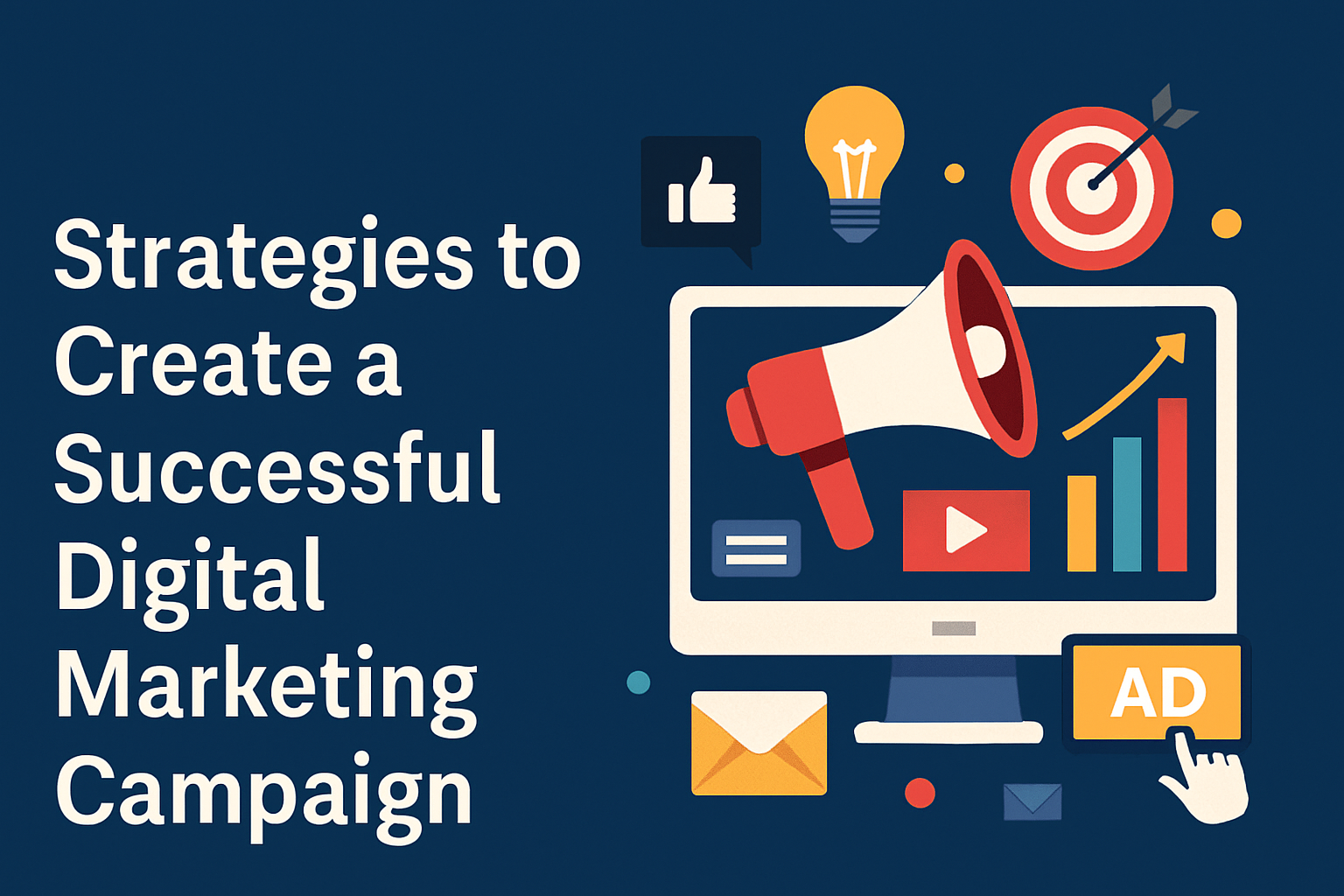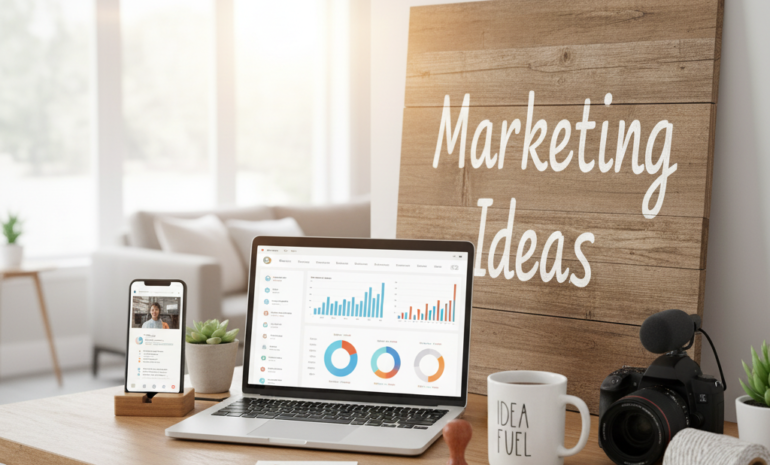Creating a digital marketing campaign is not just about placing ads or posting on social media.
It’s about using the right strategies to reach the right audience at the right time.
A well-planned campaign helps build brand awareness, generate leads, and increase sales.
In this article, you will discover the most effective strategies to create a successful digital marketing campaign that delivers real results.
Step-by-Step Guide to a Winning Digital Marketing Campaign
Here are the exact steps to build a digital marketing campaign that gets real results. Follow this proven path from planning to performance.

Set Clear and Specific
A strong digital marketing campaign starts with well-defined objectives. Without clear direction, your strategy can lose focus.
Set goals using the SMART framework; make them specific, measurable, achievable, relevant, and time-bound.
For example, instead of saying, “increase traffic,” define the target, such as “increase website traffic by 25 percent in three months.”
Clear goals not only guide decision-making but also help evaluate performance over time. They align your team’s focus, help allocate the budget correctly, and improve accountability.
Each step in your campaign should support these defined objectives, ensuring that resources are used effectively and outcomes can be accurately measured and improved.
Know Your Target Audience
Understanding who your audience is forms the core of a successful digital marketing approach.
Without a deep understanding of who your customers are, what they need, and how they behave online, your marketing messages may not connect.
Conduct market research, analyze customer data, and use insights from tools like Google Analytics and social media platforms to build audience profiles.
Develop detailed personas that reflect their age, gender, interests, challenges, and buying behaviors.
Knowing your target audience allows you to tailor your content, offers, and advertising platforms to reach them most effectively, improving engagement and increasing the chances of conversion.

Choose the Right Digital Channels
Every digital platform serves a different purpose and attracts a unique type of audience.
Choosing the right channels depends on where your ideal customers are most active.
For example, LinkedIn tends to work well for B2B brands, while visually driven platforms such as Instagram or TikTok are better suited for fashion-related businesses.
Analyze your target audience’s behavior and choose platforms that align with your marketing goals.
Avoid trying to be active on every channel without a strategy, as this can dilute your efforts. Focus on one or two high-potential platforms and create a strong presence there.
This targeted approach saves time, reduces cost, and improves effectiveness.

Create High-Quality and Valuable Content
Content serves as the backbone of every digital marketing strategy.
It must provide real value to your audience, not just promote your product or service.
High-quality content draws in visitors, keeps them interested, and encourages them to return.
Blog posts, videos, infographics, and social media updates should all address your audience’s needs, answer their questions, or solve their problems.
It is also important to maintain consistency in tone, visuals, and messaging. Content should be original, well-structured, and easy to understand.
When people find your content helpful, they are more likely to trust your brand and return for more, which increases the chances of conversion over time.
Use Strong Call-to-Actions (CTAs)
A clear and compelling call-to-action is essential in guiding your audience to take the next step.
Whether you want users to sign up, buy, download, or contact you, the CTA must be noticeable and persuasive.
Use action-oriented words such as “Start Now,” “Get a Free Quote,” or “Join Today.” Place CTAs strategically across your website, emails, and advertisements so users do not have to search for them.
Make sure the CTA contrasts visually with the rest of the content so it stands out. A well-placed CTA can significantly improve click-through rates and conversions by giving users a clear path forward.

Optimize for Mobile Devices
The majority of users today access digital content through mobile devices. Providing a mobile-friendly experience is essential for success today.
Make sure your website and marketing materials load fast and work smoothly on mobile devices.
Use a responsive design so all elements adjust according to screen size. Test your forms, buttons, and content structure to confirm that users can interact easily without zooming or scrolling excessively.
A poor mobile experience can drive users away and negatively impact your search rankings.
An optimized mobile presence improves engagement, user satisfaction, and the overall effectiveness of your marketing campaign.
Focus on SEO for Long-Term Growth
Strong search engine optimization lays the groundwork for steady and scalable online growth.
It helps attract organic traffic from people actively searching for products or services like yours.
Implement on-page SEO by using relevant keywords, writing descriptive meta titles and descriptions, and structuring content properly.
Off-page SEO involves earning backlinks from credible websites to build authority.
SEO also involves technical elements like fast loading times, mobile responsiveness, and secure connections.
Tools such as Google Search Console and Ahrefs can help you monitor performance.
Although results aren’t instant, the long-term advantages are worth the wait.
A strong SEO strategy supports visibility, trust, and consistent traffic without relying only on paid ads.

Run Paid Advertising Campaigns
Paid advertising offers an immediate way to reach your target audience and generate results.
Platforms like Google Ads, Facebook, and Instagram allow precise targeting based on demographics, location, interests, and online behavior.
Before launching, define your campaign objective, budget, and key metrics to track. Use compelling headlines, visuals, and calls-to-action to capture attention.
Monitor performance regularly and make adjustments based on real-time data. Paid ads work best when combined with organic strategies to create a balanced digital presence.
When executed properly, advertising can drive traffic, generate leads, and increase conversions while providing a measurable return on investment.
Use Email Marketing Automation
Email marketing continues to be one of the most effective digital channels for engaging with leads and customers.
Automation allows you to send timely and relevant messages without manual effort.
Create welcome series for new subscribers, follow-up sequences for leads, and re-engagement emails for inactive users.
Segment your email list based on behavior, preferences, or demographics to ensure that each recipient receives personalized content.
Use tools like Mailchimp, ActiveCampaign, or MailerLite to schedule and track emails.
A well-planned automation strategy nurtures relationships, builds trust, and moves users through your sales funnel more efficiently, ultimately improving overall conversion rates.
Implement Retargeting
Most users do not take action the first time they visit a website. Retargeting allows you to reconnect with these users through ads that appear on other websites and social media platforms.
By using tracking pixels or cookies, you can create custom audiences based on past interactions such as page visits, product views, or cart abandonment.
Craft retargeted ads that address the user’s previous behavior, such as offering a discount or reminding them of a product they viewed.
This focused strategy maintains your brand’s presence in front of potential customers and improves the chances of turning interest into action.
Retargeting offers an affordable way to reconnect with missed prospects and drive them back to your offer.
A/B Test Campaign Elements
A/B testing is essential for improving campaign performance. It involves testing two versions of a specific element, such as a headline, image, call-to-action, or color scheme, to determine which performs better.
Running controlled experiments helps you make data-driven decisions instead of relying on assumptions.
This process helps identify what resonates most with your audience. Use tools like Google Optimize or Meta Ads Manager to conduct these tests efficiently.
Begin with one element at a time and allow sufficient traffic to gather meaningful results.
Even small changes can lead to significant improvements in engagement, click-through rates, and conversions. Continuous testing ensures your campaign is always improving and adapting to audience behavior.
Analyze Campaign Performance (KPIs)
Monitoring key performance indicators is crucial for evaluating a campaign’s effectiveness.
Metrics such as click-through rate, bounce rate, conversion rate, and return on investment provide valuable insights into what is working and what is not.
Use platforms like Google Analytics, Facebook Insights, or HubSpot to monitor performance in real time.
Establish clear benchmarks and regularly compare results against your original goals. This enables timely adjustments and prevents the waste of resources.
Data should guide every decision in digital marketing. Regular analysis helps you refine your strategy, improve underperforming areas, and replicate successful tactics.
Without performance tracking, a campaign may continue in the wrong direction unnoticed.
Build Optimized Landing Pages
A well-optimized landing page is crucial for converting visitors into leads or customers.
It should be clear, focused, and free of distractions. The headline must grab attention, the content should explain the offer simply, and the call-to-action must be prominent.
Avoid clutter, unnecessary navigation, or too many options that may confuse the visitor.
Every element on the page should guide the user toward one specific action, such as filling a form or making a purchase.
Fast load speed and mobile responsiveness are also important for a smooth user experience.
An optimized landing page increases trust, reduces bounce rates, and improves the likelihood of conversion.
Leverage Social Proof (Reviews & Testimonials)
People trust the experiences of others more than any promotional message.
Including customer reviews, testimonials, case studies, and user-generated content on your website or ads builds credibility.
Social proof assures potential customers that others have benefited from your product or service. It reduces doubt and encourages action.
Display positive feedback prominently on landing pages, emails, and advertisements. Video testimonials or influencer endorsements can further enhance authenticity.
You may also highlight client logos or statistics, such as the number of users or satisfied customers.
Using social proof effectively can increase engagement, boost conversions, and create a stronger emotional connection with your brand.
Stay Updated with Trends
The world of digital marketing is always shifting and developing. New tools, platforms, algorithms, and consumer behaviors emerge frequently.
Staying informed about these trends is essential to remaining competitive.
Follow industry blogs, attend webinars, listen to expert podcasts, and subscribe to newsletters from trusted sources.
Implementing relevant trends early can give your campaigns a significant advantage.
For example, short-form videos, voice search optimization, and artificial intelligence tools are shaping how brands connect with audiences today.
Continuous learning and adaptation ensure that your strategies remain effective and do not become outdated. A proactive approach to change often leads to better results and sustained growth.
Examples of successful digital marketing campaigns
Here are some well-known examples of successful digital marketing campaigns:
Coca-Cola – “Share a Coke”
This customized strategy motivated individuals to look for bottles featuring their names and post pictures online with relevant hashtags.
It built a meaningful and personal bond between the brand and its audience. The campaign created a strong personal connection with consumers.
It led to a significant increase in sales and generated millions of organic mentions and user-generated content across social media platforms.
Nike – “You Can’t Stop Us”
During the COVID-19 pandemic, Nike released a powerful split-screen video showing athletes from different sports and backgrounds moving in sync.
The video delivered an emotional message about unity and resilience through sports.
It quickly went viral, receiving over 50 million views in its first week and reinforcing Nike’s position as a purpose-driven brand.
Old Spice – “The Man Your Man Could Smell Like”
This campaign featured a humorous and over-the-top ad with actor Isaiah Mustafa directly addressing female viewers.
It combined comedy, fast transitions, and unexpected visuals. The ad went viral and helped Old Spice rebrand itself for a younger male audience.
As a result, sales skyrocketed, and the brand became a major success story in digital advertising.
Dove – “Real Beauty Sketches”
Dove conducted a social experiment where a forensic artist sketched women based on their own self-descriptions, then again based on descriptions from strangers.
The difference revealed how women often see themselves more critically. The emotional video struck a chord globally, promoting Dove’s message of real beauty and receiving millions of views and shares.
ALS Association – “Ice Bucket Challenge”
The ALS Ice Bucket Challenge was a viral social media campaign where people dumped ice water over themselves to raise awareness and donations for ALS (a motor neuron disease).
The challenge spread rapidly, with celebrities, athletes, and influencers participating.
It raised over $100 million for research and became one of the most successful awareness campaigns ever.
How does BrandOut simplify digital campaign success?
BrandOut simplifies digital campaign success with its full-scale digital marketing services in UAE.
BrandOut manages everything from SEO, social media marketing, and PPC advertising to email campaigns and content planning, all in one place.
We focus on smart targeting, engaging content, and real-time analytics to help your brand grow faster, with less hassle.
Final Thoughts:
A powerful digital marketing campaign is not built overnight. It takes thoughtful planning, the right mix of strategies, and constant improvement.
From understanding your audience to refining content and tracking results, every step adds value.
Real examples prove that when each element aligns, success follows naturally. Stay consistent, stay relevant, and keep moving forward; that is how strong digital campaigns are created.
Most Asked Questions:
How can I measure the success of a digital marketing campaign?
Success is measured using key performance indicators (KPIs) such as website traffic, conversion rate, click-through rate, return on investment (ROI), and engagement metrics across different platforms.
Why do some digital marketing campaigns go viral?
Campaigns go viral when they tap into strong emotions, tell relatable stories, encourage sharing, and are timed well. Creativity, simplicity, and audience relevance also play major roles.
Can small businesses create successful digital marketing campaigns?
Yes, small businesses can run highly effective campaigns by focusing on niche audiences, using cost-effective platforms like social media and email, and creating authentic, valuable content tailored to their market.





